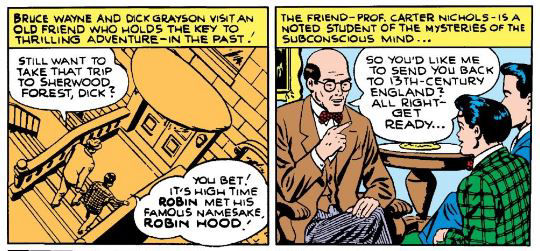
In Batman #24 (August – September 1944) a new element was added to the Batman mythos – time travel. The balding, bespectacled Professor Carter Nichols had found a way to send people back through time using hypnosis. He sent his friends Bruce Wayne and Dick Grayson back to Ancient Rome. So began a series of time travel stories that ran in the Batman comics for nearly 20 years. (Even though the time travel is achieved through hypnosis, the stories suggest the heroes’ historical adventures are genuine too. No, it doesn’t make sense to me either.)
Thanks to Professor Nichols, Batman/Bruce Wayne met the Three Musketeers (Batman #32, December 1945/January 1946) and King Arthur (Batman #36, August – September 1946). By the lead story in Detective Comics #116, time travel seemed like just an everyday activity to the Dynamic Duo. This time they were going to meet Robin Hood.

Nichols hypnotizes Bruce and Dick, and they awake to find themselves sitting on a tree. They quickly change into their Batman and Robin costumes. “And Batman and Robin behold how the king’s taxes were collected once upon a time!”
The first thing the Dynamic Duo encounters in the past is the Sheriff of Nottingham who has stopped a travelling woman and two monks. We later learn these are Maid Marian, Friar Tuck and disguised Little John.
Batman speaks out against the injustice. And upon hearing that the tax gatherer is a sheriff, Batman has little respect for his legal authority. It seems that travelling into classic literature, hundreds of years past has relieved Batman of his law-abiding responsibilities as he’s once again the outlaw hero of his earliest appearances.
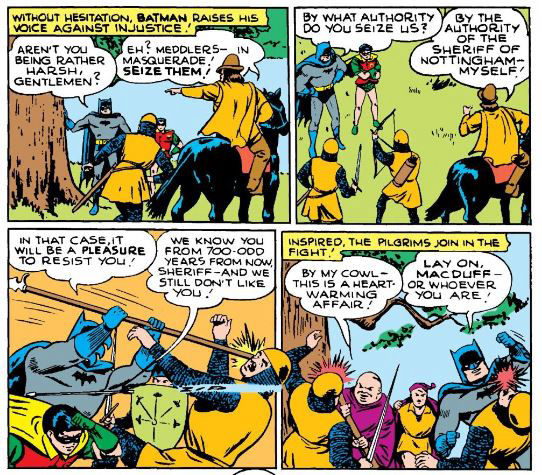
The caped crusaders, aided by Friar Tuck and Little John, easily overcome the sheriff’s goons. Also, they do have help from an arrow that "whistles out of nowhere". Robin the Boy Wonder is overtaken by the spirit of classic adventure. He picks up a bow and considers shooting an parting arrow at the fleeing sheriff. Even though Robin is not confident of his aim, Batman seems unconcerned about any possibility of a lethal misfire.
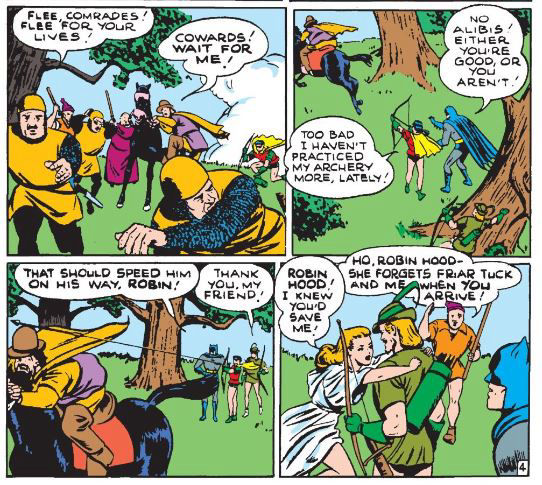
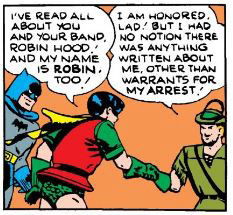
The Boy Wonder certainly is quick to establish he's a fan of Robin Hood - having read all about him and even sharing the same name. It's amusing at this time there appear to be no books or ballads about the outlaw hero. All Robin Hood has read about himself are the arrest warrants.
Robin Hood invites the two strangers back to join them for a feast at the outlaws’ camp. As they talk about their life, Robin Hood begins to explain “For the false King John helped himself to our estates! There is my own case …” And again, Batman’s impetuous sidekick interrupts to show off his future knowledge.
ROBIN (Boy Wonder): I know, Robin Hood – you are the Earl of Huntingdon, a Saxon noble, loyal to King Richard the Lion-Hearted, so the new Norman king seized your lands!
ROBIN HOOD (Outlaw): But not he nor the thieving Sheriff of Nottingham can ever make freemen yield to slavery!
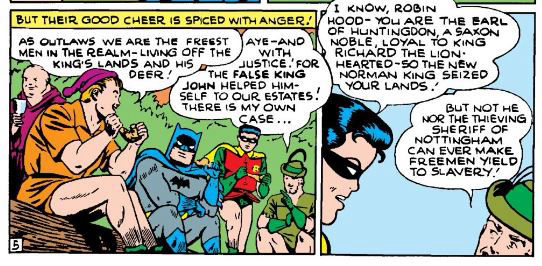
Notice that King John is called "false" and the sheriff is "thieving". This helps establish that it is Robin Hood's enemies who are the true criminals. The idea of a feast is a common trope in the Robin Hood legend, but an even more common one was about to appear.
Meanwhile, one of the sheriff’s henchmen devises a scheme to trap Robin Hood. As I’m sure anyone with even a passing familiarity with the Robin Hood legend can guess, they plan to hold an archery tournament and offer a golden arrow as a prize.
When the Boy Wonder reads the posted notice in Sherwood Forest, he recognizes the plot from "the book". It's another meta-element -- the heroes know they are in a storybook. Friar Tuck hasn't read any such books, but he knows how this notice would appeal to Robin Hood's ego.
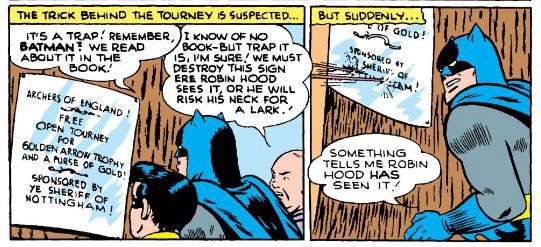
Of course, Robin Hood has already seen the notice, and he persuades the others to go along disguised in hooded cloaks. Both Robin Hood and Robin the Boy Wonder participate in the archery contest. The Boy Wonder manages to land an arrow dead centre in the bull’s-eye which astonishes even him. Robin Hood declares “I can better your shot only by splitting the shaft!” The Boy Wonder, who appears to forget his knowledge of the legend for a moment, exclaims “It might be done – once in a million tries.” Of course, Robin Hood does split the arrow. Just to prove his point, Robin looses several more arrows, each splitting the previous one.
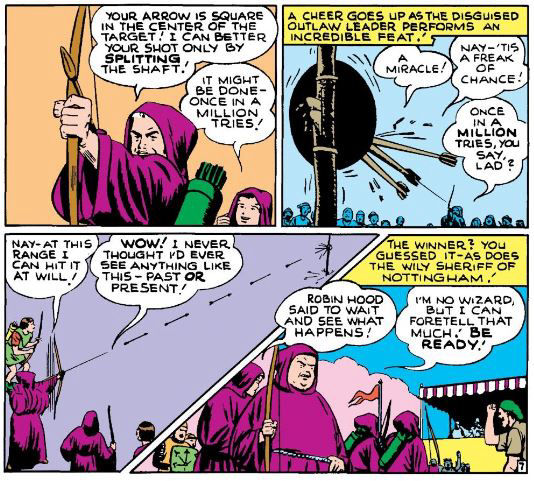
The sheriff knows who is Robin Hood and immediately orders his arrest. The guards seize a disguised Robin Hood and Batman. Batman uses his belt radio to say to not rescue them now, get away and await orders. The Merry Men think the concept of a radio is magic, but they agree and return to the forest where they impatiently wait.
Meanwhile, Robin Hood and Batman are chained up in a dungeon. Batman takes a vial of acid from his utility belt and melts through the shackles. He then proceeds to file a key for the door. The medieval outlaw is impressed that Batman carries "tools enough for a tinker!"
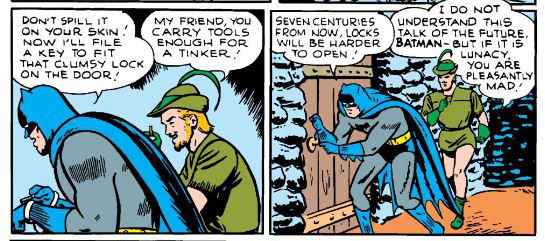
The caption declares “And now, a 20th century miracle opens a 13th-century melodrama!” Batman uses the radio to summon the Boy Wonder and the Outlaws of Sherwood to come to the castle. Batman and Robin Hood look out from the castle’s turret and use rope arrows to lower the drawbridge, so that the outlaws can storm the castle.
With the battle won, Robin Hood, Batman and Robin confront Sheriff.
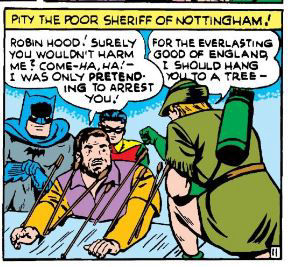
SHERIFF: Robin Hood! Surely you wouldn't harm me? Come-ha, ha! I was only pretending to arrest you!
ROBIN HOOD: For the everlasting good of England, I should hang you to a tree.
MARIAN: No, Robin Hood! There is enough violence in the land!
BATMAN: Besides, King John and his underlings are well beaten, thanks to bold men like you! ... Already the barons of England plan to force the king to sign a paper restoring their lands and rights -- a document to be called Magna Charta (sic) -- the great charter!
ROBIN HOOD: How you know this I cannot say, but I believe you, Batman!
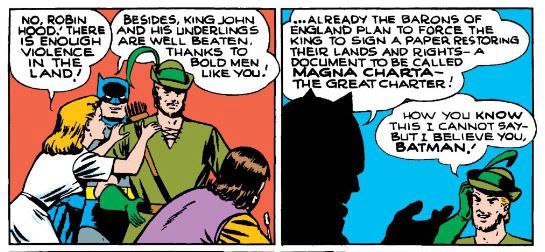
Robin Hood's threat of killing the Sheriff of Nottingham is both keeping with the original ballads, and also the early Batman stories. But while Batman killed his enemies in some of the earliest adventures, such bloodshed was no longer a part of the comics.
By bringing up the Magna Carta, Batman introduces the concept of the law. The true victory will come not from Robin Hood's archery but from a legal document.This stray comment not only adds a rare element of genuine history to this adventure, but it shows even in medieval outlaw tales, law and order will triumph.
As the adventure is over, Batman and Robin fade away to present. Bruce Wayne and Dick Grayson come out of their hypnotic trance, and Professor Nichols mentions how strange it is they can't stop talking about Batman and Robin.
Dick Grayson is impressed by how the legend of Robin Hood has lasted through the centuries, but Bruce Wayne adds the true moral of the story. "The world forgets its tyrants, Dick -- but never does it forget those heroes who fight for human rights!"
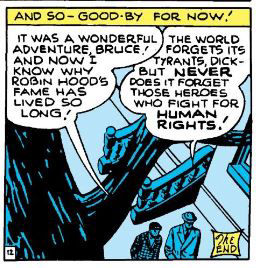
TThis issue uses what have become some classic Robin Hood tropes. The archery contest dates back to the 15th century ballad A Gest of Robyn Hode and the later ballad Robin Hood and the Golden Arrow. The outlaw didn’t split the arrow in those earlier ballads, but he does split the arrow in Sir Walter Scott’s Ivanhoe, the Paul Creswick/N.C. Wyeth retelling that inspired the Boy Wonder’s name and costume, and the 1938 Errol Flynn film. Later time travel stories have also used the archery contest story, the 1960 Mr. Peabody and Sherman cartoon, the 1982 episode of Voyagers! and the 2014 “Robot of Sherwood” episode of Doctor Who. The raid on the castle is also a standard Robin Hood trope in film and literature. Robin Hood contemplates hanging the sheriff, and this something he did in the ballad Robin Hood Rescuing Three Squires. This fleeting thought is quickly dismissed by Marian, and with it is gone the only real trace of Robin Hood – the outlaw rather than Robin Hood – the superhero. While Batman and Robin meet a Robin Hood inspired by the popular 1938 film starring Errol Flynn, this comic book Robin Hood is watered down from even his cinematic counterpart.
Easily the best known saying about Robin Hood is that he robs from the rich and gives to the poor. And yet there is neither robbing nor giving in this issue. Well, actually, that’s not quite true. The sheriff’s men try to rob Friar Tuck and Maid Marian. Robin Hood’s act of forest banditry has been taken from him and given to his villains. The Robin Hood of this story might fight injustice, but he does not steal.
As mentioned in the previous section, the early Batman and Robin stories showed them roughing up and playing tricks on corrupt authority figures. But by 1946, they were strictly law-abiding “duly-deputized officers of the law”. And yet Batman seems to have no issues helping an outlaw to fight the sheriff. They know the sheriff is bad and refer to the king as false, but they don’t spell out how the circumstances are different than 20th century Gotham City. Then again, as United States’ founding tales are of overcoming bad English kings and evil English tax collectors, Batman’s actions in this story would likely be seen as patriotism rather than rebellion.
Batman and Robin aren’t the first time travellers from DC Comics to visit Sherwood Forest. That honour belongs to Green Arrow and Speedy.
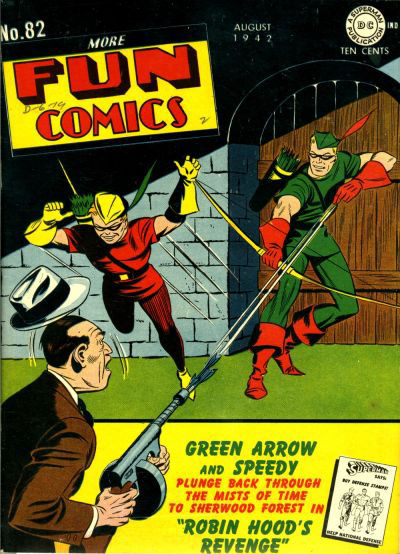
Green Arrow Meets Robin Hood
More Fun Comics #82
August 1942
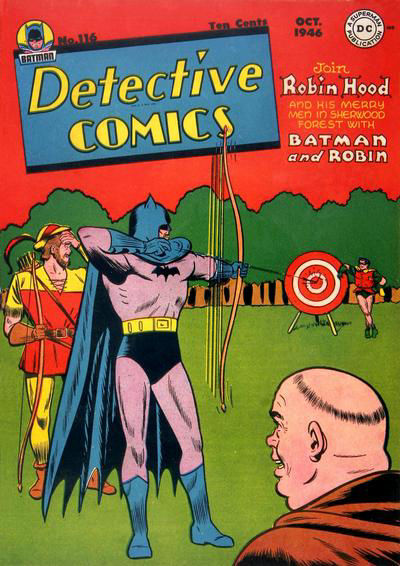
Batman Meets Robin Hood
Detective Comics #116
October 1946
Introduced in More Fun Comics #73 (November 1941) by Mort Weisinger and George Papp, Green Arrow is millionaire playboy Oliver Queen who fights crime with the aid of his youthful ward Roy Harper aka Speedy. If that sounds suspiciously like Batman and Robin, it’s because in their early days, these two archers were little more than Batman and Robin rip-offs in Robin Hood costumes, using special tricks arrows instead of the gimmicks in Batman would find in his utility belt.
Less than a year after Green Arrow’s debut, “Robin Hood’s Revenge” appeared in More Fun Comics #82 (August 1942) drawn by George Papp (the writer was uncredited). The heroes stop a crooked scientist who manufactured time pills – capsules that when swallowed send a person back in time. Speedy can’t resist trying those pills and finds himself back in the 12th century where Guy of Gisborne tries to arrest Speedy and sentence him to death for being one of Robin Hood’s men. Robin Hood himself shows up and they battle the evil soldiers. Finally Green Arrow follows his sidekick back into the past and saves the day. Robin Hood brings the two strangers to his camp and is impressed by their ability to split his arrows. The outlaw leader asks for the two strangers to join his band, but unlike Batman in the 1946 story, Green Arrow and Speedy are hesitant to accept Robin Hood’s offer.
SPEEDY: Join with you? That would be swell! But …. I've heard that you rob people and ...
ROBIN HOOD: A tale spun by such false rogues as those who would have hanged ye! I but force the real robbers of the poor to share their spoils with their victims! My men have sworn an oath to do no mischief to poor men, honest yeoman or courteous knights ... but defend the weak and the poor!
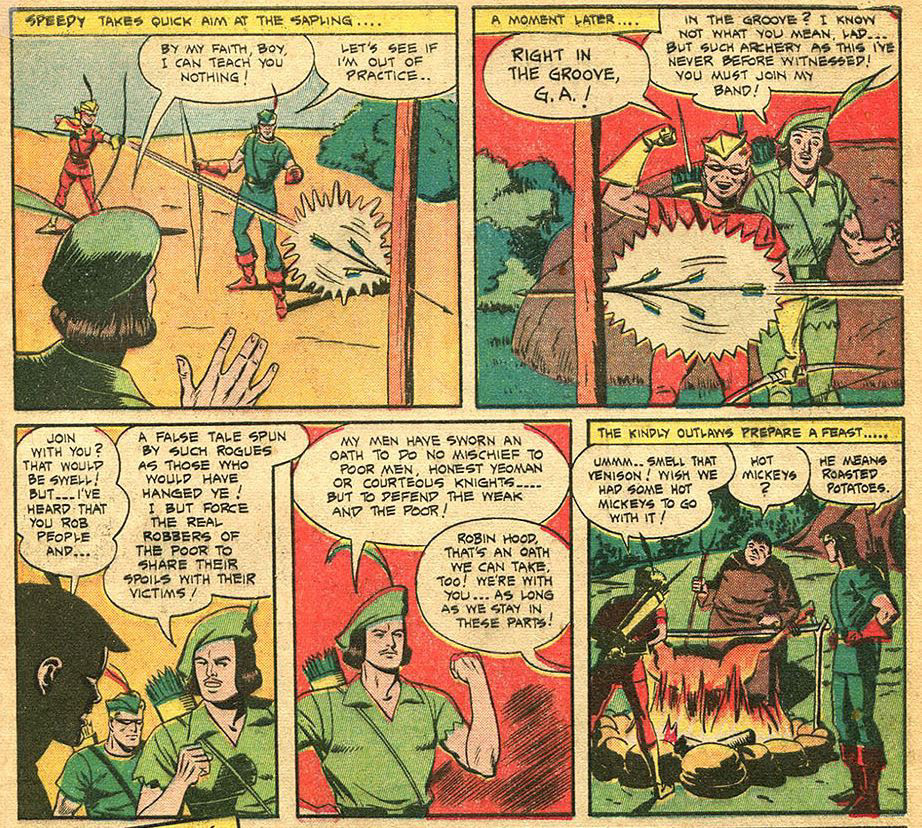
Green Arrow and Speedy are satisfied with the explanation and agree to follow Robin Hood. The idea that Robin Hood takes from the real robbers was also made explicit in the 1950s Robin Hood comics, such as Robin Hood Tales also published by DC Comics.
However, later the sheriff frames Robin Hood for the murder of an innocent, and he convinces Green Arrow that Robin Hood’s speech was just “smooth talk”. Green Arrow agrees to help capture the outlaw, and he explains to Speedy: "We've made it our life's work to turn guilty people over to the law, Speedy! ... And I'd make it my business to see that he gets a fair trial, and be acquitted if innocent." Speedy remarks that the sheriff’s men were going to hang him without trial if not for Robin Hood’s rescue.
Green Arrow captures Robin Hood and turns him in. Only then does he begin to wonder if he did the right thing.
GREEN ARROW: It was my duty … and yet I can’t help distrusting the sheriff and Guy of Gisborne. I wonder if they’ll give Robin a fair trial.
SPEEDY: This is a swell time to admit it!
When they learn that Robin Hood is indeed sentenced to death without a trial, the time travellers join the Merry Men to storm the castle. Robin Hood is rescued, the sheriff and Gisborne flee, and finally Green Arrow and Speedy return to their own time.
Batman’s adventure in the past is bland and inconsequential compared to Green Arrow’s. While the Green Arrow story excuses away Robin Hood’s outlaw behaviour, at least that story addresses the outlaw hero’s best known attributes. The Batman story doesn’t even consider that Robin Hood is a criminal of sorts.
But in the 1966 Batman TV series, Batman and Robin encounter a modern-day Robin Hood criminal called the Archer. That story addresses the “robbing from the rich and giving to the poor” motif head-on. That TV episode will be covered in great detail in a later section.
But first I want to look a little deeper at the do-gooder versions of Batman and Robin from the 1950s and 1960s. The Boy Wonder is about to acquire his most famous catchphrase.
I wrote a full-length look at this and other times Green Arrow Met Robin Hood over at my Green Arrow site.
NEXT:
PART 5: The Caped Crusaders in 1950s and 1960s Comic Books and Television
PART 6 - Batman and Robin Meet the Archer (1966 TV episodes)
PART 7 - Robin Leaves the Nest (1969 - 1975)
PART 8 - The Dynamite Duo and Goodbye, Hudson University (1975 - 1980)
PART 9 - Robin No More: The Birth of Nightwing (1980 - 1984)
PREVIOUSLY:
PART 1 - The Golden Age of Comics and the Development of the Kid Sidekick
PART 2 -What's In A Name? Robin and Robin Hood
PART 3 - Early Adventures (including Robin's origin)
Contact Us